Dehydrator or Air Fryer: Kitchen Gadget Face-Off
Dehydrator vs. air fryer debate has kitchen enthusiasts talking about their unique benefits.
The two appliances serve different purposes despite some overlapping functions.
Many home cooks find themselves choosing between them based on specific meal preferences.
The air fryer excels at creating crispy textures with minimal oil, making favorites like french fries healthier.
Meanwhile, a good dehydrator helps preserve seasonal fruits and vegetables for months of enjoyment.
Each machine brings its own set of advantages to modern cooking methods.
With both options available today, you can transform how meals are prepared in your kitchen - keep reading to learn which might become your next essential appliance.
Dehydrator: Essential Guide
Dehydrators work much like ovens, using gentle heat and flowing air to dry food over time, but they don't actually cook anything - they simply remove moisture.
Many people rely on these handy devices to keep their food fresh for months or even years.
The basic setup consists of a heat source, fan, multiple trays for holding food, and vents to release humidity.
Once the machine warms up, moisture begins to leave your fruits, vegetables, or meats while the fan system pushes that damp air outside through ventilation openings.
This straightforward process makes food preservation accessible to anyone who wants to reduce waste and enjoy seasonal foods throughout the year.
Using A Dehydrator Right
Getting top-notch results from your dehydrator is easier than you think with a few simple tricks. For starters, all food pieces should be uniform in size and thickness to ensure they dry at the same rate.
Make sure to properly sterilize everything before it goes into the machine, as cleanliness prevents spoilage and extends shelf life. The trays need breathing room, so avoid packing them too tightly with food items.
Your dehydrator will work most efficiently when placed in a warm, dry area of your home rather than a damp or cool spot.
The Pros And Cons Of A Dehydrator
Check this table for advantages and disadvantages of using dehydrator.
| Pros | Cons |
| Preserves food for long-term storage | Takes several hours to dehydrate food |
| Retains most nutrients and flavor | Uses electricity continuously |
| Saves space compared to freezing | Initial cost can be high for quality |
| Easy to use with consistent results | Requires trial and error for best results |
| Great for making snacks like jerky, dried fruit, and herbs | Limited capacity depending on model size |
Common Dehydrator Types
Dehydrators come in two main types that people love to use at home. Both of them are easy to use.
Vertical Flow Dehydrator
A vertical flow dehydrator has a timeless design, usually round and barrel-shaped. It has a fan and heating system either at the top or bottom that creates circular airflow. This design works best for drying fruits and vegetables evenly.
Horizontal Flow Dehydrator
The horizontal flow dehydrator is larger and more expensive, making it ideal for big families. Its box shape and multiple fans create even, parallel airflow from the back to heat food evenly. This type handles thicker foods like meats and jerky really well.
The Overview of Air Fryer
An air fryer is a popular kitchen appliance designed to cook food by circulating hot air around it at high speed. This tool lets anyone cook without oil, working just like a small convection oven.
Most models come with a simple design - a pull-out drawer, a food basket with an easy-to-grab handle, a heating element at the top, and controls on the outside panel.
Thanks to this intense air movement, foods get that perfect crispy outside and juicy inside.
This method uses little to no oil, making it a healthier alternative to traditional deep frying.
How to Use an Air Fryer Effectively
Getting the best results from your air fryer isn't complicated once you know a few key tips. Never overfill the basket as this prevents proper air circulation and leaves food unevenly cooked.
A quick 3-5 minute preheat before adding ingredients makes a huge difference in cooking quality. Safety matters too - your air fryer generates significant heat, so place it away from walls and other appliances on a heat-resistant surface.
Each recipe needs the right temperature setting to avoid burnt exteriors and raw centers. Regular checks and gentle shaking of smaller items like fries or nuggets ensure everything cooks evenly.
Cleaning after each use prevents flavor transfer and buildup - the basket and drawer just need a quick wash with warm soapy water.
The Pros And Cons Of Using An Air Fryer
Here are some pros and cons when you use an air fryer.
| Pros | Cons |
| Cooks food quickly and efficiently | Limited cooking capacity for large meals |
| Requires little to no oil, making meals healthier | Can produce a slightly dry texture if overcooked |
| Easy to use with adjustable temperature and timer | Initial cost can be higher than traditional appliances |
| Creates crispy, fried-like textures without deep frying | Some models can be bulky and take up counter space |
| Less mess and easier cleanup compared to deep frying | Not ideal for all types of cooking (e.g., soups, large roasts) |
Types Of Air Fryers
Several new air dryer options have hit the market to match what customers want, including basket, oven, and paddle-type models. Keep reading to see what they are.
Basket Air Fryer
This model has a removable basket that makes cleaning simple—you just pull it out and rinse it. The basket has holes to allow hot air to circulate evenly and crisp food quickly, especially at the bottom.
Oven Air Fryer
Resembling a small oven, this type includes multiple trays and racks. It offers more cooking space and extra functions like toasting, rotisserie, and baking, making it very versatile.
Paddle-Type Air Fryer
The most expensive version features a paddle that automatically stirs the food, allowing even cooking on all sides. It’s especially good for cooking larger items like whole chickens without manual turning.
The Similarities Of Dehydrators And Air Fryers
Dehydrators and air fryers share several important similarities despite their different cooking purposes. Here are some key points about their similarities.
Oil-Free Food Outcome
Both dehydrators and air fryers excel at cooking food without needing to immerse it in oil. This oil-free approach means the food retains a healthier profile, with less added fat and fewer calories.
Dehydrators remove moisture to preserve and intensify flavors, while air fryers use hot air to create a crispy texture similar to frying but with minimal or no oil.
Heat and Fan Systems
Both appliances rely on the combination of heat and fans to circulate hot air evenly around the food.
In dehydrators, the airflow is typically gentler and lower-temperature, designed to slowly dry food over several hours.
Air fryers, however, use more intense heat and powerful fans to rapidly cook food and produce a crispy outer layer within minutes.
This shared technology highlights their efficiency in using convection heat to prepare food without oil, but the specific temperature and airflow design cater to their distinct cooking purposes.
Timers
Having adjustable timers is a crucial feature in both dehydrators and air fryers. Timers allow users to set precise cooking durations to suit different types of food and recipes.
For dehydrators, longer times at lower temperatures are common, which requires careful timing to ensure food dries properly without overdoing it.
Air fryers generally use shorter cooking times at higher temperatures, and the timer helps avoid overcooking or burning.
Safety and Convenience
The compact designs of dehydrators and air fryers contribute to safer and more convenient kitchen experiences.
Their size means they’re easy to place on countertops without crowding space, and most models include features like cool-touch exteriors and automatic shut-off to prevent accidents.
Removable trays and baskets simplify cleaning, reducing hassle compared to traditional deep frying or oven use.
Dehydrator or Air Fryer; What Are Differences?
While dehydrators and air fryers both use hot air circulation, their purposes, designs, and results vary significantly.
Purpose and How They Work
Dehydrators and air fryers both use hot air, but they have very different jobs. Dehydrators gently dry out food by removing moisture over a long time at low temperatures, which helps preserve it for months or even years.
This makes dehydrated snacks great for hiking or storing leftovers. Air fryers, on the other hand, cook food quickly at high heat by circulating super hot air to create that crispy, fried texture - without needing much oil.
They’re perfect when you want a tasty, healthier meal in a hurry.
Design and Capacity
Dehydrators usually come with several stackable trays, so you can dry different foods all at once or make a big batch of your favorites. They’re great if you want to preserve lots of fruits, veggies, or jerky at one time.
Air fryers tend to have a single basket or chamber, which means they have less space inside. Most air fryers hold about 6 liters, so cooking for a crowd means you might need to do a few rounds, but they’re compact and easy to store on your countertop.
Types of Food You Can Cook
Dehydrators are best for drying fruits, veggies, herbs, and lean meats like jerky, basically anything you want to preserve or turn into a snack. Air fryers are way more flexible and can handle everything from crispy fries and chicken wings to baked goods like muffins or even pizza.
If you’re looking for an all-around quick cooker, the air fryer has you covered.
Temperature and Cooking Time
Dehydrators work at low temperatures, around 140°F, and take several hours, sometimes even a full day, to properly dry food. It’s a slow and steady process that preserves flavor and nutrients.
Air fryers cook at much higher temperatures, usually between 300°F and 400°F, and whip up meals in less than 30 minutes. So if you’re in a rush for dinner, the air fryer is the way to go.
For Dehydrators
Here is a quick review for the right temperature in cooking these types of foods in a dehydrator.
| Types of Food | Recommended Temperature | Expected Drying Time |
| Fruits | 149°F (65°C) | 12–24 hours (varies by type) |
| Vegetables | 113°F–122°F (45°C–50°C) | 13–18 hours (varies by type) |
| Fish | 158°F (70°C) | More than 24 hours |
| Meat | 158°F (70°C) | More than 24 hours |
| Herbs | 104°F (40°C) | 2–7 hours |
For Air Fryer
For cooking in an air fryer, you should take note these temperature for these foods, such as:
| Types of Food | Recommended Temperature | Expected Cooking Time |
| Whole chicken | 350°F (177°C) | 45–60 minutes |
| Lamb | 386°F (196°C) | 25–35 minutes |
| Bacon | 350°F (177°C) | 8–12 minutes |
| Salmon | 375°F (190°C) | 10–15 minutes |
| Shrimps | 350°F (177°C) | 6–10 minutes |
| Vegetables | 350°F (177°C) | 10–20 minutes |
| Dumplings | 400°F (204°C) | 8–12 minutes |
| French fries | 400°F (204°C) | 15–20 minutes |
| Pizza | 375°F (190°C) | 8–12 minutes |
Food Quality and Usage
Foods from a dehydrator come out completely dried and ready to eat or store for months, making them perfect for snacks or long trips. The texture is chewy or crunchy, depending on what you’re drying.
Air-fried foods come out hot, crispy, and delicious, ready to eat right away. They’re healthier than deep-fried foods since they use less oil, but leftovers might not keep as well once reheated.
Energy Use and Convenience
Dehydrators use energy over a longer period because they run for many hours, but you can set them and forget them while they do their thing. Air fryers use more power during short cooking times and have easy controls like timers and temperature dials that make cooking simple and fast.
Both are convenient countertop appliances that make healthier cooking accessible.
Why You Should Choose Dehydrator or Air Fryer
Choosing between a dehydrator and an air fryer really depends on what you want to achieve in the kitchen.
If you’re looking to preserve food for long-term storage, create healthy snacks like dried fruits, veggies, or jerky, or reduce food bulk for easy travel, a dehydrator is your best friend.
It gently removes moisture over several hours, locking in flavors and nutrients without cooking the food, making it ideal for anyone who loves prepping ahead or enjoys natural, shelf-stable snacks.
If you want quick, crispy, and healthier versions of your favorite fried foods without the mess and excess oil, an air fryer is perfect.
It cooks meals fast using hot air circulation to mimic frying, offering a convenient way to enjoy delicious, low-fat meals in minutes.
Buying Guide for The Best Dehydrator or Air Fryer
Below are some tips to help you choose the best dehydrator or air fryer:
Best Brand for Buying Dehydrator or Air Fryer
Based on recent reviews and expert opinions, here are five top-rated brands for food dehydrators and air fryers:
Dehydrator Brands
Air Fryer Brands
Got Questions? We’ve Got Solutions
1. Can I use a dehydrator and an air fryer interchangeably?
While there's some overlap, they serve different purposes. Air fryers excel at quick cooking with crispy results, while dehydrators specialize in slowly removing moisture to preserve foods. You can dehydrate in some air fryers, but dedicated dehydrators typically do a better job with consistent, low-temperature drying.
2. Which appliance is more energy-efficient?
Dehydrators use less power (typically 300-800 watts) but run for many hours. Air fryers use more power (1400-1700 watts) but operate for shorter periods. For single batches of food, air fryers are generally more energy-efficient, while dehydrators may be better for large-batch food preservation.
3. How do cooking times compare between the two?
Air fryers cook quickly - often in 10-25 minutes. Dehydrators work slowly, taking anywhere from 4-15 hours depending on the food and desired dryness. This time difference reflects their fundamentally different cooking approaches.
4. Which one is better for beginners in the kitchen?
Air fryers are typically more beginner-friendly with simple controls, quick results, and familiar cooking outcomes. Dehydrators require more patience and experimentation with drying times, but the processes themselves are straightforward.

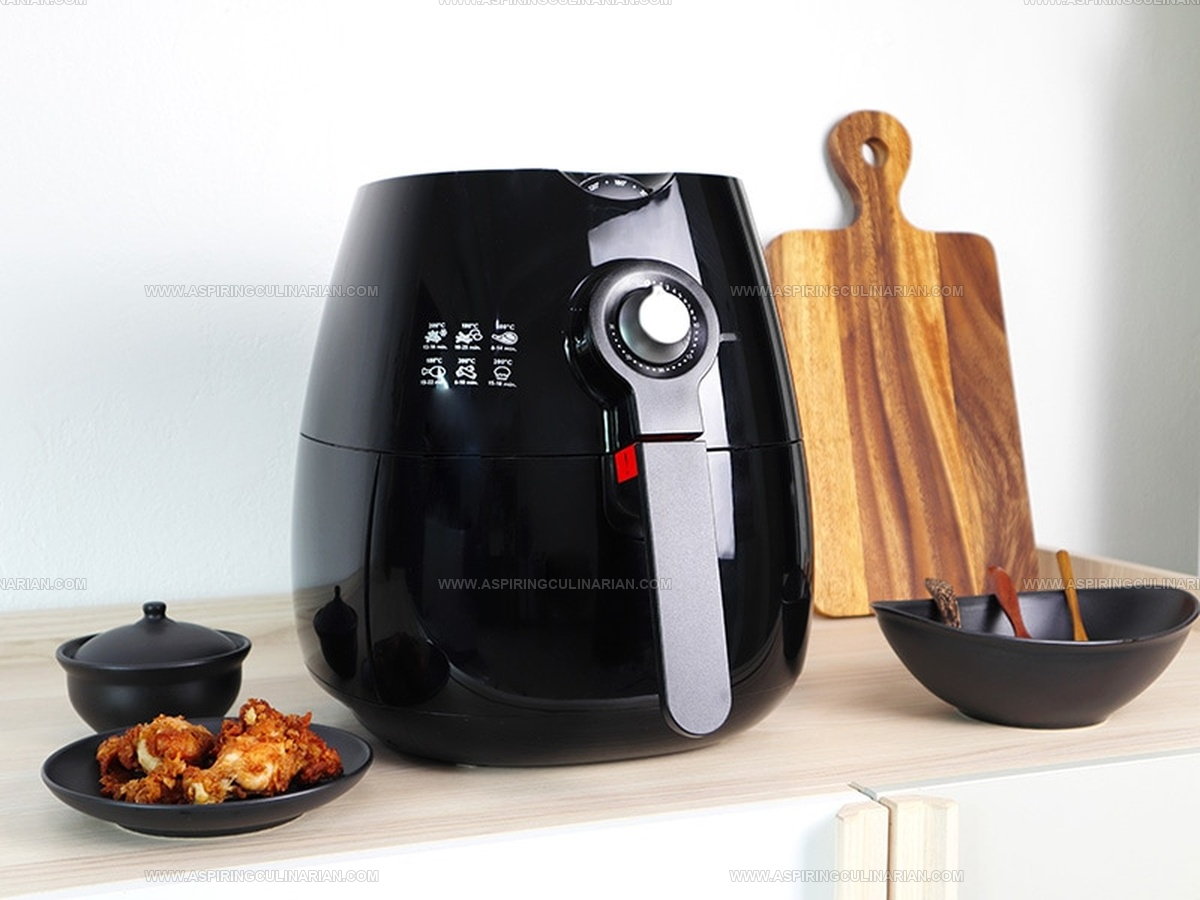
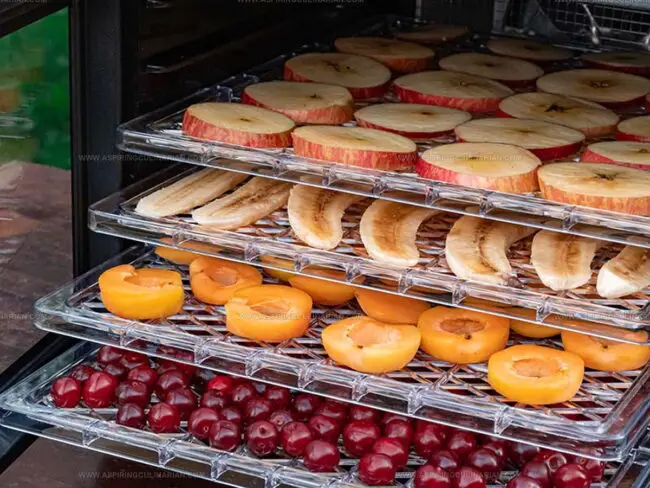
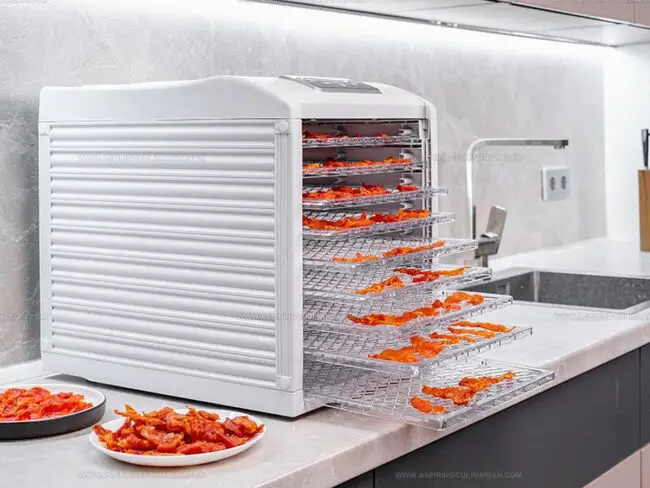
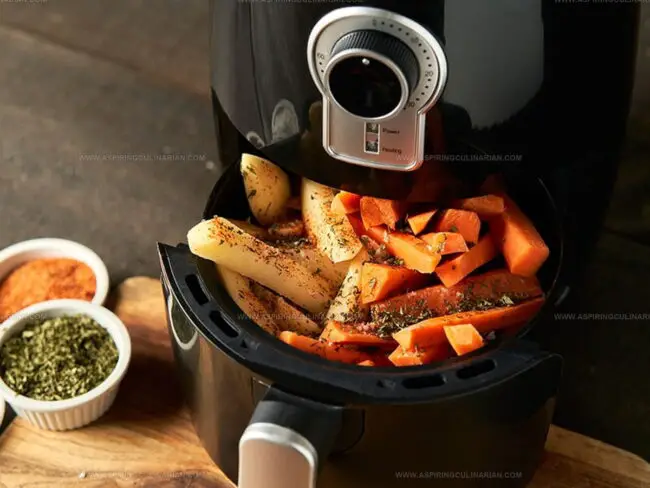
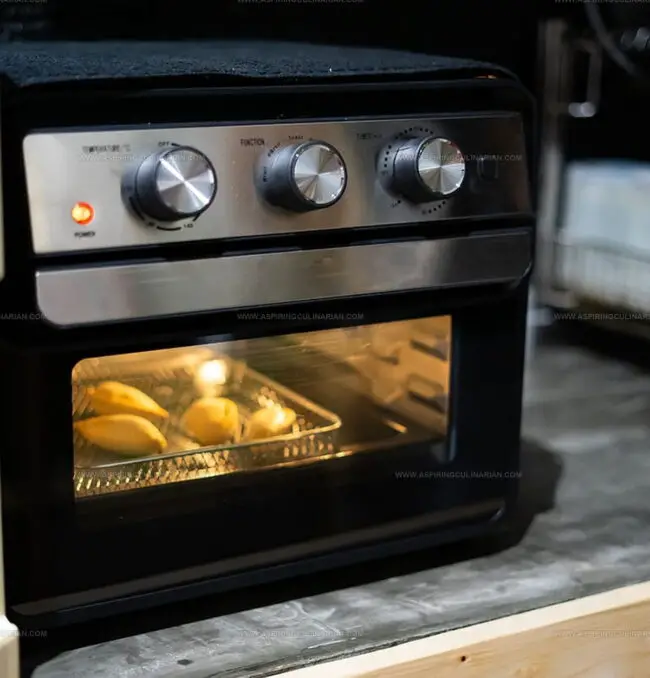
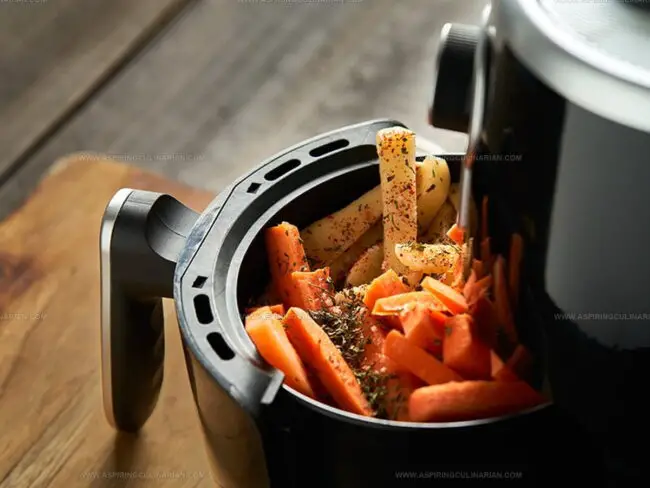
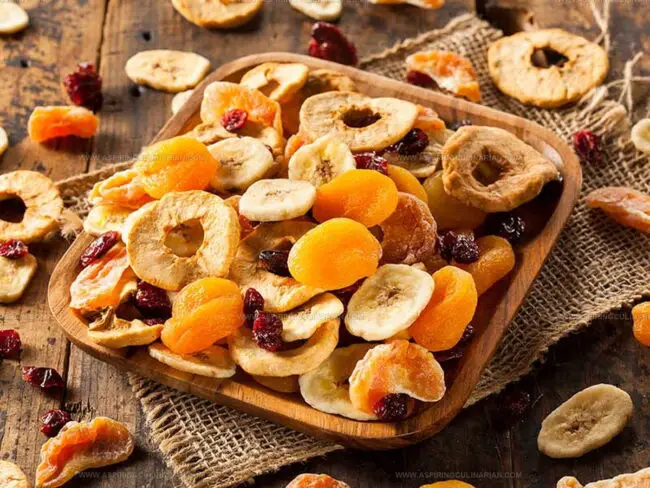
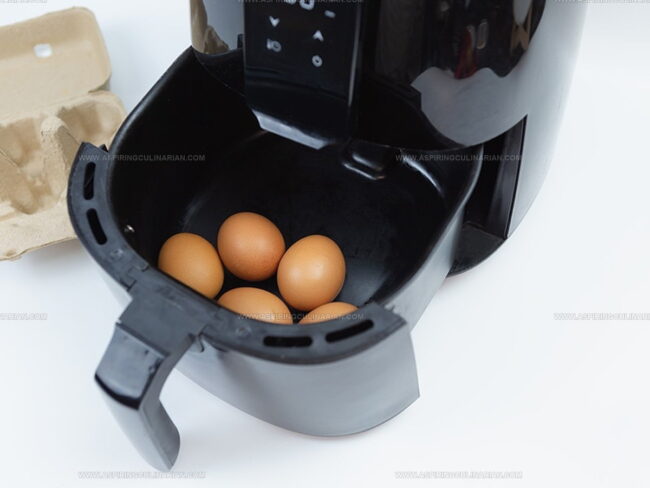
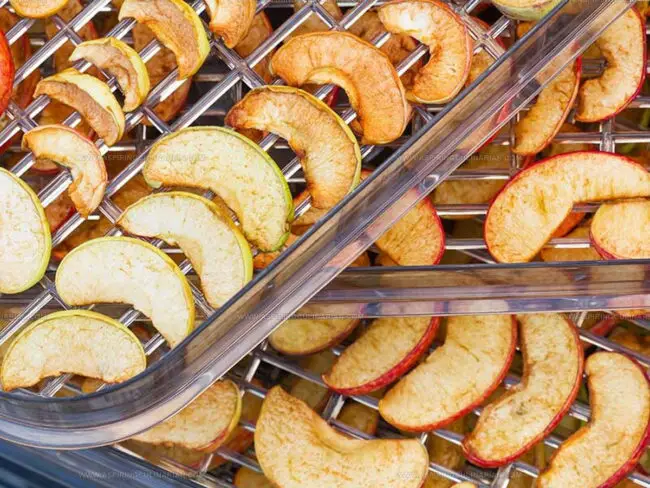
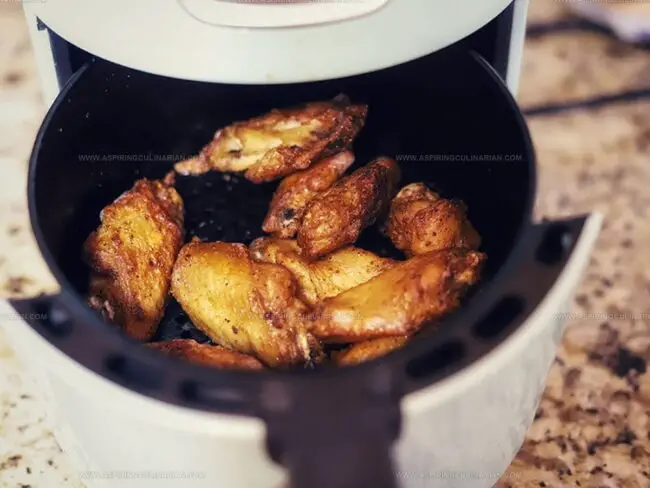
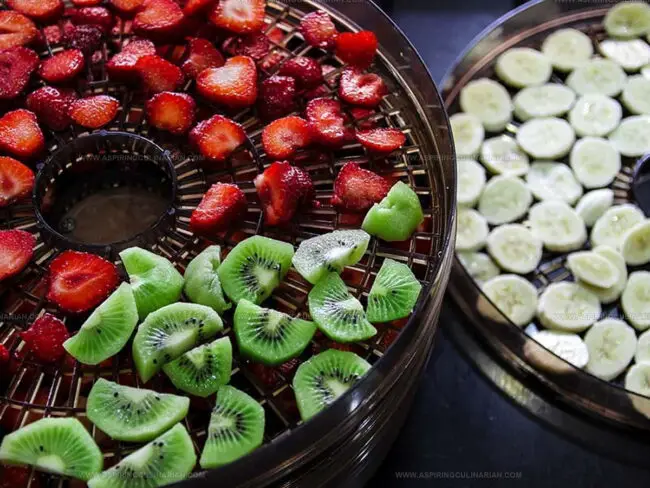
Nathaniel Brooks
Founder & Recipe Developer
Expertise
Farm-to-table cuisine, Seasonal recipe development, Culinary storytelling
Education
Ivy Tech Community College – Indianapolis, IN
Culinary Arts / Hospitality Administration & Events
Focused on hands-on training in classical and modern culinary techniques.
Nathaniel’s story starts in the foothills of the Appalachian Mountains, where farm stands, backyard gardens, and old family recipes shaped his love for real food. After graduating from Ivy Tech Community College in Indianapolis, he spent years working in farm-to-table kitchens, learning how to turn local, seasonal ingredients into something memorable.
Today, Nathaniel pours that same spirit into every single recipe on Aspiring Culinarian – recipes that feel real, comforting, and connected to the land. When he’s not in the kitchen, you’ll find him foraging wild herbs, chasing sunsets with his camera, or writing about the flavors that shaped his roots.